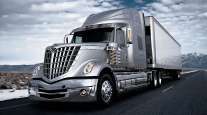Navistar Touts Progress of Its SCR Engine Switch
This story appears in the June 3 print edition of Transport Topics.
LISLE, Ill. — Navistar International Corp. continued the relaunch of its Class 8 truck business late last month, holding test drives for two new emissions-compliant engine families in the suburbs around its Chicago-area headquarters.
Company leaders showed off their work of successfully modifying Navistar’s own MaxxForce 13-liter power plant and squeezing the Cummins ISX 15-liter engine into the ProStar and 9900 heavy-duty models.
The May 23 event for a group of trucking journalists here was the culmination of “a journey we’ve been on for 10 months,” said Troy Clarke, Navistar’s CEO.
The company has effectively been out of the Class 8 business since late August, when it stopped trying to get federal emissions approval for its line of engines and decided to switch to selective catalytic reduction, in line with all of its North American competitors.
That change led to the retirement of CEO Daniel Ustian and the eventual selection of Clarke to succeed him.
Navistar has been working to fit the Cummins engine into its trucks and to add a Cummins SCR emissions package to its own MaxxForce 13 engines.
“Frankly, it’s been hard to sell product,” Clarke told the group of journalists May 23. “Our market share is low right now, around 14.5%,” down from more than 18% last year.
“Now we’re selling. . . . We’ve got some good stuff to tell customers and we’re out there selling,” Clarke said. “We’ll earn our way back in” to customers’ good graces, he added.
Clarke said he couldn’t predict what sales results will be in the short term, but his goal was “to have a sales run rate at the end of our fiscal year that is the same as what we were doing before the emissions problems.
“We are going to be the best in quality and in customer satisfaction,” Clarke added. “We’re not the fuel economy leader today . . . but we’re going to be.”
He said the speedy retooling for the SCR engines didn’t allow Navistar enough time to remove some now-redundant systems that prevent the vehicles from maximizing fuel economy.
In recent years, Navistar generally has been in second place in Class 8 sales in North America, trailing only the Freightliner brand of Daimler Trucks North America.
The Cummins 15-liter engine is now available in every truck model Navistar intends to offer it in, and the 13-liter MaxxForce is currently available in the ProStar and 9900 and will be available in every model in which it will be offered by the end of August, officials said.
Steve Schrier, a Navistar spokesman, said the company has about 5,500 orders for Class 8 trucks with ISX engines and about 1,500 for vehicles with the MaxxForce.
Navistar already has recorded more than 1 million test miles
on ISX engines in the company’s ProStar trucks, according to David Majors, the company’s vice president of product development.
He said that the MaxxForce engine burns so cleanly that it requires virtually no manual regeneration cycles, but Cummins had added a timer to start a cleaning cycle every 24 hours.
Majors said there has been a wave of interest in the 9900 — a severe-service model that is older than the ProStar — since the company decided to offer it with the ISX engine. “We’ve had more orders in the past few weeks than in the last two years,” he said.
He said Navistar officials were happy to be working with Cummins again: “It’s like old friends getting back together.”
Relations between Navistar and Cummins were strained several years ago when the engine maker reversed course and decided to use SCR in its engines. Navistar had been expecting Cummins to deliver engines that utilized exhaust gas recirculation.
Navistar then dropped Cummins as a supplier for its North American products, although it did continue to install Cummins engines in some of the trucks it manufactured in Mexico.
Meanwhile, Clarke said all the company’s efforts on natural gas engines are “on pause” as officials focus on getting the SCR diesel engines into their trucks.
Clarke said he expected natural gas engines to become an important portion of their business, but for now the company had to focus on the core business.
Previously, Navistar officials had planned to offer natural gas engines in every one of the product lines.
Company officials last month also took the journalists on a tour of Navistar’s nearby expanded Melrose Park engine-testing facility and medium-duty engine plant.
Steve Nash, Navistar’s operations director for product integration and validation, said some $90 million has been invested in new testing equipment at the facility’s 56 vehicle bays.
Every new engine is tested at the facility before it is placed in a truck.
The plant — which was built in 1941 to manufacture engines for B-24 Liberator bombers by Buick — now encompasses 650,000 square feet of floor space. The company, then called International Harvester, purchased the plant in 1946 to build construction equipment.
Navistar also produces engines for its medium-duty trucks at the plant.




